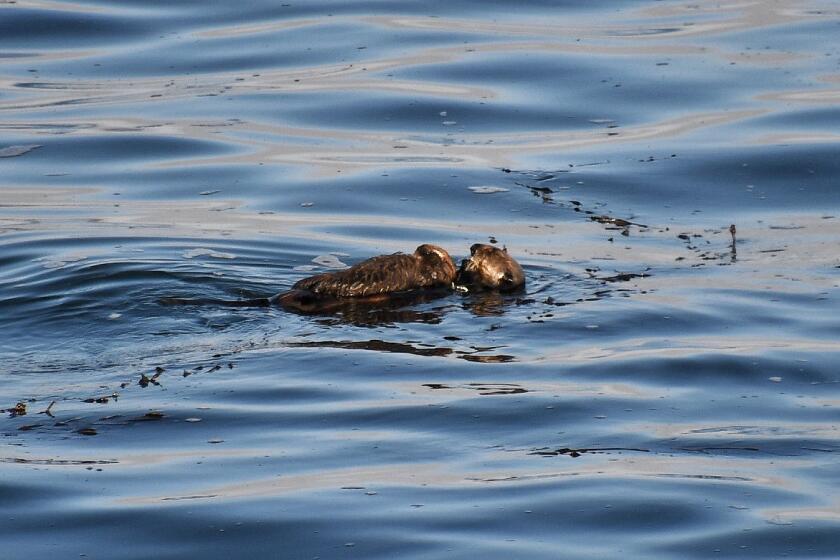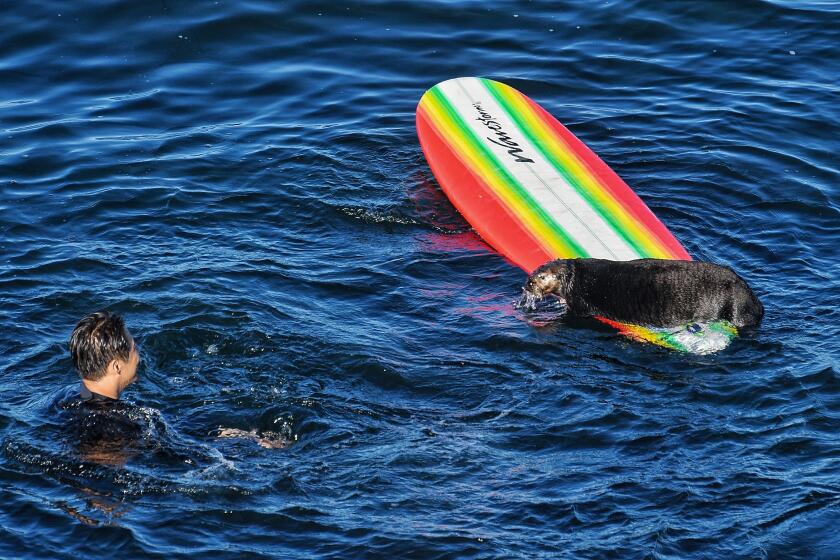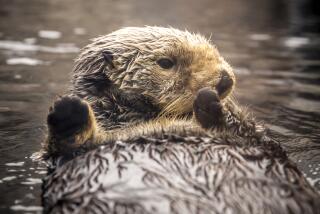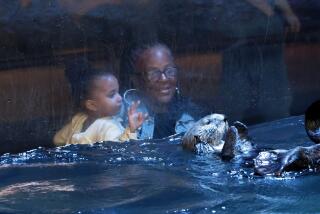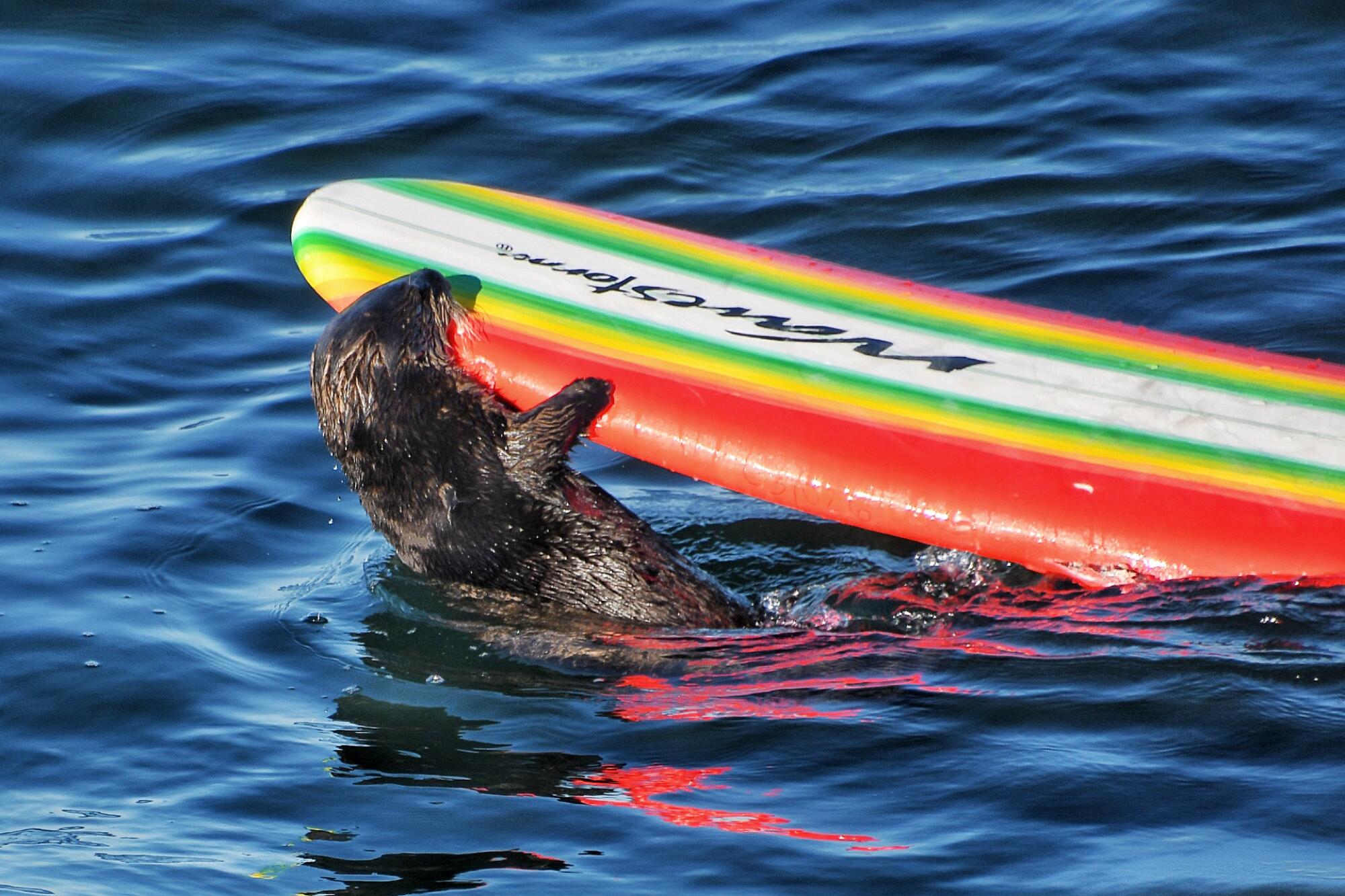
Social media lighted up this past holiday weekend with the return of Santa Cruz’s most infamous sea mammal: the surfboard-stealing Otter 841.
“841 is back in the 831 at Steamer Lane,” Mark Woodward crowed on the social media platform X. Steamer Lane is one of the seaside town’s most popular surfing sites, and 831 is the Santa Cruz area code. Woodward is a social media influencer known as Native Santa Cruz.
Observers of the Santa Cruz Longboard Union Memorial Day contest captured photos and videos of an otter calmly cleaning herself atop a board she’d hijacked, which she shared peacefully with a gobsmacked surfer.
Woodward said that although that critter was probably 841 — the behavior seemed entirely in line — he was unable to provide a 100% positive identification; he couldn’t see the hallmark blue tag affixed to her left flipper after being born in and then released from captivity.
He had, however, seen the 6-year-old otter in the vicinity over the weekend — and he captured several photos that he posted online — after a five-month hiatus. She disappeared with her pup as December storms rolled in across the Pacific and walloped California’s Central Coast.
Santa Cruz’s sea otter, 841, has given birth to a wee pup — suggesting that her erratic behavior could have been hormonally driven.
“She disappeared the year before too,” he said, noting that she was nowhere to be seen between September 2022 and early June 2023. “Seems to be her pattern.”
He said he did not see her pup with her over the weekend, but that was to be expected. Otters generally nurse their young for only six to eight months before weaning them and sending them off to crab, fish and independently interact with their environment.
Otter 841 was seen accompanied by a small otter — presumably her pup — throughout October and November, putting her baby’s age at around 7 or 8 months.
“Sea otters are naturally wary of people, but some individuals exhibit aggressive tendencies that may be exacerbated by pregnancy, illegal feeding, or repeated exposure to close approaches by people,” Vanessa Morales, a spokeswoman for the U.S. Fish and Wildlife Service, said in a statement.
She said there were no immediate plans to capture 841, and she asked the public to be “extra cautious when recreating around sea otters.”
“If a sea otter approaches you, that is abnormal behavior. It is your responsibility to avoid and discourage these interactions,” she said.
Otter 841 grabbed national attention last year as she chased surfers and their boards throughout the legendary surf spots hugging the California coast between Santa Cruz’s lighthouse and wharf. For months, federal officials tried to capture her, but she eluded their attempts. They finally gave up and urged surfers, swimmers and boaters to steer clear of the curious otter.
Woodward said government agencies have reached out directly to him, pleading with him to tell his tens of thousands of followers on X, Instagram and Facebook to keep away from 841.
“For their safety, stay at least 50’ away from sea otters and all marine life, it’s the law and also common sense, so please help keep them safe,” he wrote on Facebook.
An ornery, board-jacking sea otter is terrorizing surfers off the coast of Santa Cruz. An effort is underway to capture the creature.
Sea otters were once found from Mexico to Alaska, and even Japan, according to the Monterey Bay Aquarium’s website. Today, that range has become much smaller. In California, only about 3,000 otters live along a 300-mile expanse from Half Moon Bay to Point Conception. There’s a much bigger population in Alaska, and a few are still observed in Russia.
Sea otters were once hunted for their fur, which is what lead to their dramatic decline, and they are now listed as a threatened species.
It is unclear what drives 841’s surfboard-aggressive behavior. Biologists noted that her mom had exhibited similar behaviors, suggesting that 841 either learned from her mother, inherited those tendencies or maybe a little of both.
Her mother had been fed in the wild by people, which may have led to her comfort around humans — as well as her curiosity. Wildlife officials say it is dangerous to feed wild animals not only because of concerns about physical contact, but it also can create this kind of behavior — which ultimately endangers the animal.
Morales, the federal spokeswoman, had recommendations for people who encounter 841 while surfing, boating or swimming:
If an otter approaches: Stay calm and immediately move away. Do not try to photograph, touch, pet or feed the otter.
If the otter pursues you or somebody you are with: Wave your arms and get loud. Slap the water with your paddle, oar or hand. Try splashing water toward the otter. If you’re on a boat or board, bang on the vessel with a paddle or your hand.
If all none of that works and the otter persists or climbs aboard: Use a paddle or another object to block the otter, or push it off your craft. Morales noted that federal laws protect sea otters, and harassing or injuring a sea otter is illegal. However, a gentle nudge is considered acceptable if it was employed as a last-ditch effort to protect yourself and the otter from harm. She said you can also try to rock your kayak or board, making it an unstable platform. She said people should not attempt to move the otter with their hands, and by no means try to touch or pet the otter or pause to take pictures. As soon as the otter is off the vessel, leave.
If you are out with your dog and encounter an otter: Never allow your dog to chase, harass, play with or otherwise interact with an otter, she said. A dog can injure an otter, and an otter can injure or kill a dog. In addition, interactions can result in disease transmission that could harm the otter, your dog or you.
She asked people to recognize that posting videos and photos of sea otter encounters only promotes similar wildlife interaction by others.
“Use care when you share,” she said.
